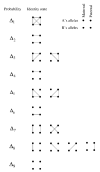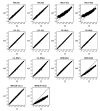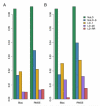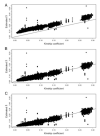Identity by descent estimation with dense genome-wide genotype data
- PMID: 21769932
- PMCID: PMC3587128
- DOI: 10.1002/gepi.20606
Identity by descent estimation with dense genome-wide genotype data
Abstract
We present a novel method, IBDLD, for estimating the probability of identity by descent (IBD) for a pair of related individuals at a locus, given dense genotype data and a pedigree of arbitrary size and complexity. IBDLD overcomes the challenges of exact multipoint estimation of IBD in pedigrees of potentially large size and eliminates the difficulty of accommodating the background linkage disequilibrium (LD) that is present in high-density genotype data. We show that IBDLD is much more accurate at estimating the true IBD sharing than methods that remove LD by pruning SNPs and is highly robust to pedigree errors or other forms of misspecified relationships. The method is fast and can be used to estimate the probability for each possible IBD sharing state at every SNP from a high-density genotyping array for hundreds of thousands of pairs of individuals. We use it to estimate point-wise and genomewide IBD sharing between 185,745 pairs of subjects all of whom are related through a single, large and complex 13-generation pedigree and genotyped with the Affymetrix 500 k chip. We find that we are able to identify the true pedigree relationship for individuals who were misidentified in the collected data and estimate empirical kinship coefficients that can be used in follow-up QTL mapping studies. IBDLD is implemented as an open source software package and is freely available.
© 2011 Wiley-Liss, Inc.
Figures







Similar articles
-
Using identity by descent estimation with dense genotype data to detect positive selection.Eur J Hum Genet. 2013 Feb;21(2):205-11. doi: 10.1038/ejhg.2012.148. Epub 2012 Jul 11. Eur J Hum Genet. 2013. PMID: 22781100 Free PMC article.
-
Multipoint quantitative-trait linkage analysis in general pedigrees.Am J Hum Genet. 1998 May;62(5):1198-211. doi: 10.1086/301844. Am J Hum Genet. 1998. PMID: 9545414 Free PMC article.
-
Identity-by-descent estimation and mapping of qualitative traits in large, complex pedigrees.Genetics. 2008 Jul;179(3):1577-90. doi: 10.1534/genetics.108.089912. Epub 2008 Jul 13. Genetics. 2008. PMID: 18622032 Free PMC article.
-
Linkage disequilibrium across two different single-nucleotide polymorphism genome scans.BMC Genet. 2005 Dec 30;6 Suppl 1(Suppl 1):S86. doi: 10.1186/1471-2156-6-S1-S86. BMC Genet. 2005. PMID: 16451701 Free PMC article.
-
Ancestral haplotype reconstruction in endogamous populations using identity-by-descent.PLoS Comput Biol. 2021 Feb 26;17(2):e1008638. doi: 10.1371/journal.pcbi.1008638. eCollection 2021 Feb. PLoS Comput Biol. 2021. PMID: 33635861 Free PMC article.
Cited by
-
Pedigree-Free Descent-Based Gene Mapping from Population Samples.Hum Hered. 2015;80(1):21-35. doi: 10.1159/000430841. Epub 2015 Jul 24. Hum Hered. 2015. PMID: 26228693 Free PMC article.
-
Methods and results from the genome-wide association group at GAW20.BMC Genet. 2018 Sep 17;19(Suppl 1):79. doi: 10.1186/s12863-018-0649-0. BMC Genet. 2018. PMID: 30255814 Free PMC article.
-
Joint inference of identity by descent along multiple chromosomes from population samples.J Comput Biol. 2014 Mar;21(3):185-200. doi: 10.1089/cmb.2013.0140. J Comput Biol. 2014. PMID: 24606562 Free PMC article.
-
Genetic Origin and Introgression Pattern of Pingliang Red Cattle Revealed Using Genome-Wide SNP Analyses.Genes (Basel). 2023 Dec 11;14(12):2198. doi: 10.3390/genes14122198. Genes (Basel). 2023. PMID: 38137021 Free PMC article.
-
Optimized selection of unrelated subjects for whole-genome sequencing studies of rare high-penetrance alleles.Genet Epidemiol. 2012 Jul;36(5):472-9. doi: 10.1002/gepi.21641. Epub 2012 May 23. Genet Epidemiol. 2012. PMID: 22623060 Free PMC article.
References
-
- Abecasis GR, Cherny SS, Cookson WO, Cardon LR. Merlin–rapid analysis of dense genetic maps using sparse gene flow trees. Nat Genet. 2002;30:97–101. - PubMed
Publication types
MeSH terms
Grants and funding
LinkOut - more resources
Full Text Sources
Other Literature Sources
Research Materials

